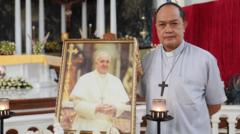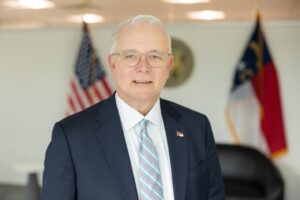On May 7, 2025, the conclave to elect the next pope of the Roman Catholic Church started in the Sistine Chapel. As cardinals take their oaths and begin the secretive voting process, the church grapples with pressing issues including financial strains and historical scandals. The outcome remains uncertain as potential successors vie for support within a divided ecclesiastical landscape.
Papal Conclave Begins in Vatican: A Historic Vote for New Leadership

Papal Conclave Begins in Vatican: A Historic Vote for New Leadership
The first voting round for the new pope commenced inside the Sistine Chapel, involving 133 cardinals amidst the legacy of Pope Francis and the church's challenges.
---
Gathered under the stunning frescoes of the Sistine Chapel, 133 members of the College of Cardinals convened on May 7, 2025, to initiate the papal conclave that will determine the next leader of 1.4 billion Roman Catholics. This momentous event follows the recent death of Pope Francis and is steeped in a longstanding tradition that combines secrecy, ritual, and spiritual reflection.
The cardinals entered the chapel after attending a solemn Mass at St. Peter’s Basilica, their final public event before entering a period of seclusion with no access to phones or the internet. Once inside, they took an oath to uphold the rules of the conclave, pledging to maintain absolute confidentiality regarding their discussions and voting. This conclave marks the first occurrence in over a decade, reflecting a time of uncertainty for the church, which seeks to navigate its financial troubles and address the fallout from past sex abuse scandals.
Following the oath-taking, an initial vote was conducted, although many observers anticipate that achieving the required two-thirds majority for a successful election may take more than one round, leading the cardinals to spend the night at Vatican guesthouses and reconvene the next day. The voting process, defined by two rounds each day, is visually communicated to the world through the smoke emitted from the chapel's chimney—black smoke indicates a lack of consensus, while white smoke signifies the election of a new pope.
The identities of potential candidates bring an additional layer of complexity to the proceedings, as many of the voting cardinals, appointed by Pope Francis, engage in discussions for the first time. Prominent figures include Cardinal Pietro Parolin, Francis' former right-hand man, and Cardinal Luis Antonio Tagle of the Philippines. The church now stands at a crossroads, with cardinals grappling over whether to continue along the path of inclusivity and openness heralded by Francis or to revert to more conservative principles that could reshape Catholic outreach in the contemporary world.
As the world turns its gaze to the Vatican, symbols and traditions take on renewed significance. A solitary seagull circling above the chapel quickly captured the public's imagination, echoing a similar moment during the last conclave in 2013 when a bird perched at a critical juncture before the announcement of Pope Francis.
With cardinals now engaged in their essential task, they are not only electing a successor to Saint Peter, but also determining the future trajectory of the Roman Catholic Church during uncertain times. Amidst this rarest of electoral processes, the breadth of choices and profound implications underscore the weight of their decisions, both for the church's internal dynamics and for the fidelity of its global congregation.
Gathered under the stunning frescoes of the Sistine Chapel, 133 members of the College of Cardinals convened on May 7, 2025, to initiate the papal conclave that will determine the next leader of 1.4 billion Roman Catholics. This momentous event follows the recent death of Pope Francis and is steeped in a longstanding tradition that combines secrecy, ritual, and spiritual reflection.
The cardinals entered the chapel after attending a solemn Mass at St. Peter’s Basilica, their final public event before entering a period of seclusion with no access to phones or the internet. Once inside, they took an oath to uphold the rules of the conclave, pledging to maintain absolute confidentiality regarding their discussions and voting. This conclave marks the first occurrence in over a decade, reflecting a time of uncertainty for the church, which seeks to navigate its financial troubles and address the fallout from past sex abuse scandals.
Following the oath-taking, an initial vote was conducted, although many observers anticipate that achieving the required two-thirds majority for a successful election may take more than one round, leading the cardinals to spend the night at Vatican guesthouses and reconvene the next day. The voting process, defined by two rounds each day, is visually communicated to the world through the smoke emitted from the chapel's chimney—black smoke indicates a lack of consensus, while white smoke signifies the election of a new pope.
The identities of potential candidates bring an additional layer of complexity to the proceedings, as many of the voting cardinals, appointed by Pope Francis, engage in discussions for the first time. Prominent figures include Cardinal Pietro Parolin, Francis' former right-hand man, and Cardinal Luis Antonio Tagle of the Philippines. The church now stands at a crossroads, with cardinals grappling over whether to continue along the path of inclusivity and openness heralded by Francis or to revert to more conservative principles that could reshape Catholic outreach in the contemporary world.
As the world turns its gaze to the Vatican, symbols and traditions take on renewed significance. A solitary seagull circling above the chapel quickly captured the public's imagination, echoing a similar moment during the last conclave in 2013 when a bird perched at a critical juncture before the announcement of Pope Francis.
With cardinals now engaged in their essential task, they are not only electing a successor to Saint Peter, but also determining the future trajectory of the Roman Catholic Church during uncertain times. Amidst this rarest of electoral processes, the breadth of choices and profound implications underscore the weight of their decisions, both for the church's internal dynamics and for the fidelity of its global congregation.






















